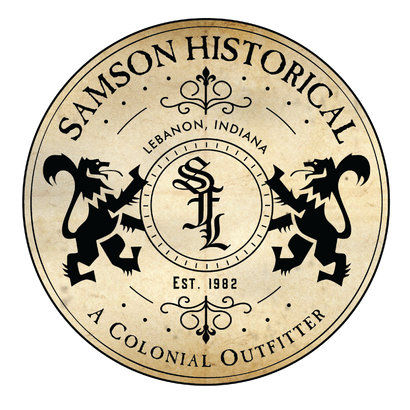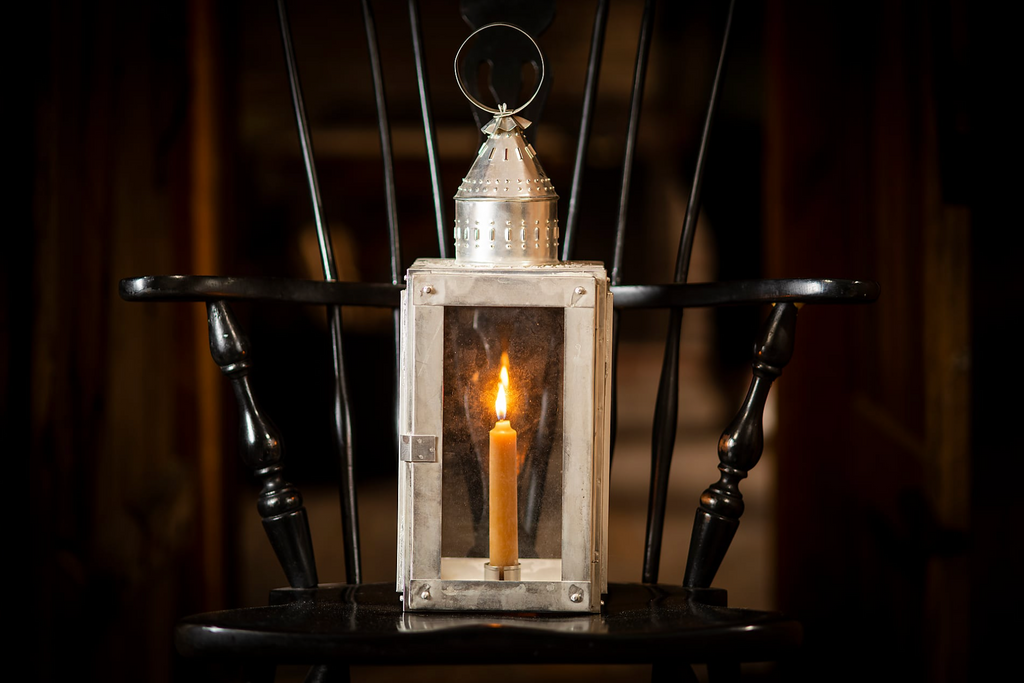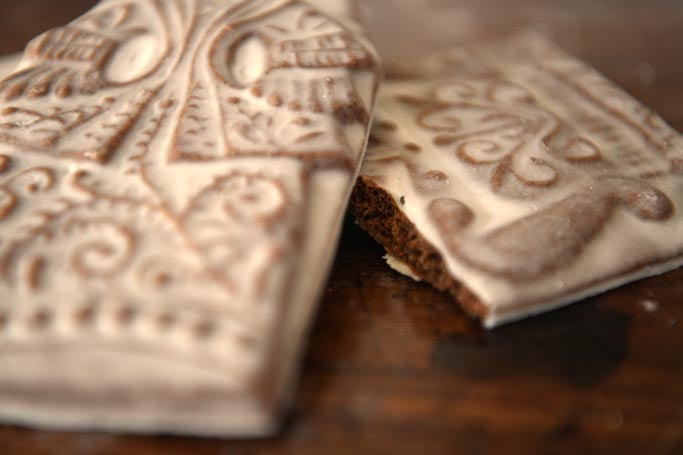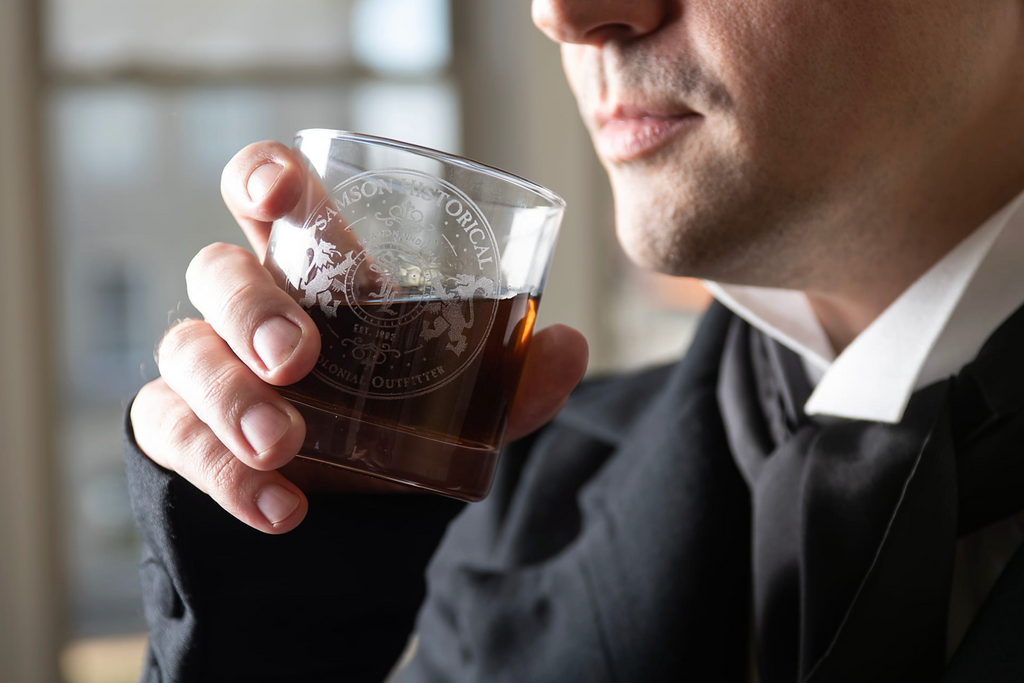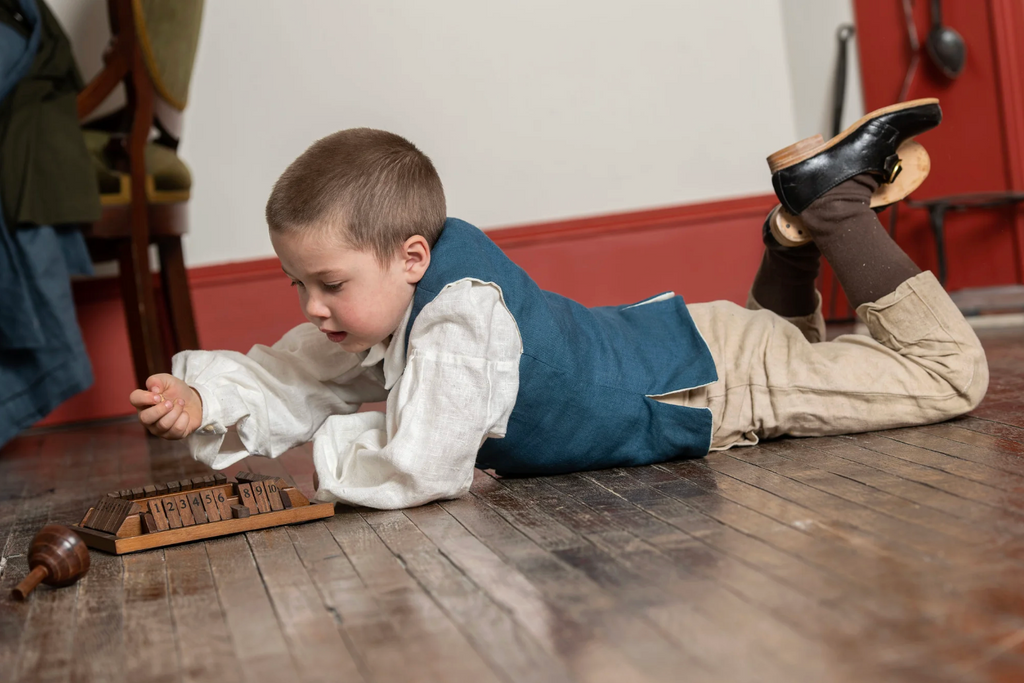Men’s Clothing
Women’s Clothing
Children's Clothing
Ice Cream In The 18th Century
by Hannah McIntire 13 min read

by Amy E. O’Neal
A humorous anecdote passed around the English-language newspapers, appearing in Philadelphia in 1797, tells the story of an “honest sea officer” who went to dine in Sicily:
… after the second course was removed, ices in the shape of various fruits were advanced by way of rear guard, as is the custom in those places. One of the servants carried the figure of a fine large peach to the Captain, Who, (unacquainted with deceit of this Kind) never doubted but it was a real one, and cutting it through the middle, in a moment had one half of it in his mouth … he began to tumble it about from side to side in his mouth, water running out of his eyes, till at last, able to hold no longer, he spit it out upon his plate, claiming, with a horrid oath, “A painted snowball, by G—!”
The captain then threatens to beat the Sicilian waiter, and much merriment is had by all. Whether or not any such thing happened, readers could have believed it -- both that the Italians could make an ice dessert that looked just like a peach and that a rough-edged Englishman would not recognize it.
In the 1700s, new ideas about food and new ways of eating were slowly becoming established on European tables, at least for those who could afford to eat well and try novelties. Ice cream was one such novelty. During the 18th century, however, changes in the world and in the kitchen would bring ice cream much closer to what it became in the 19th and 20th centuries: a democratic dessert, with strong sentimental ties to America and to the Italian diaspora.
Preserving ice to cool drinks and food is a practice as old as at least the second millennium B.C.E. The origin of ice cream -- that is, the first frozen dairy food -- is surrounded by legend. During the T’ang dynasty (618–907 C.E.) in China, milk, rice, and camphor were mixed into a ice-chilled delicacy called “clear wind rice.” But this dish was only cold, not frozen, and Marco Polo did not, as some say, bring ice cream recipes back from China. Some credit Bernardo Buontalenti of Florence with the first gelato, a crema fredda made in 1565.
In any case, early ice cream, together with the cold flavored desserts of snow that inspired it, was a privilege of the wealthy before the 18th century. Snow and ice could be specially ordered from mountain provinces, as it was in Italy, and stored in icehouses, but sweetened ice desserts were rare.
At the beginning of the 18th century, that remained true. But as the century passed the halfway mark, ice cream grew more popular as it became more widely available. In 1700, a guest at a wealthy man’s table might have a piece of a glistening molded crème glacee; in 1796, a gentleman passerby in Philadelphia could visit the City Tavern and buy ice cream almost as readily as he could buy a cup of coffee.
To create ice cream, much less to make enough of it to keep and sell, one needs four key ingredients -- sugar, salt, clean ice, and skill -- that had always been scarce for European confectioners, even those who served the wealthy.
Cold Food and Health
Although people have always made and enjoyed sweet confections, the European concept of dessert itself is relatively young. In medieval French and British cuisine, sweet and savory often appeared together. This was not entirely a matter of differing tastes. Those who had the resources to plan their meals took into account the nature of each food to keep their humors balanced and their minds and bodies healthy. But in the 17th century, diners began to lose interest in the precise balance of their foods as fashions changed.


The increasing popularity of fresh fruits provoked the disapproval of physicians. The doctor James Hart said “most fruits yeeld but bad”; fresh fruits threatened to unbalance the body due to their inherently cold and moist qualities. What, then, could be more cold and moist than a fruit-flavored ice?
Sixteenth-century doctors condemned ice out of hand. By the 18th century, however, medical opinion had changed. In 1775 and again in 1784, a doctor from Naples, Filippo Baldini, published De sorbetti saggio (On the Wisdom of Sorbetti), a treatise on the health benefits of flavored ices. The belief in the unhealthiness of cold food gave way to the sensation of refreshment.
Ice in All Seasons
In the 19th century, an international trade in natural ice and the popularization of mechanical ice manufacture made it possible for many more people and institutions to chill and store food as well as create frozen confections. But in the 18th century, confectioners and cooks who wanted to make fruit and cream ices still had to look to the local ice trade, if there was one, and to patrons’ ice houses for their supplies.
Elizabeth David’s book “Harvest of the Cold Months” discusses how Europeans could preserve or obtain ice prior to the 19th century. All over Europe, snow might be preserved in a stack made in the winter, covered with straw and rushes. Ice houses, permanent structures insulated with earth and keeping the ice well below ground level, first appeared in Britain in the 17th century at the orders of a new clientele. Wealthy British travelers who returned from the continent, particularly Naples and Sicily, developed a taste for ice and all it could do, and built ice houses to keep their own supplies.
In Naples, ice and snow came not only in winter but by a regular trade from the mountains, and it was kept in bucchi di neve (snow holes), cellars, or natural caves below Monte Sant’Angelo. The use of snow and ice was so popular throughout the city that it was perhaps no surprise that a Neapolitan developed the key to the manufacture and service of ice cream.
Italy as the Home of Ice Cream
In 1558, the alchemist Giambattista della Porta published a new discovery. By mixing ice with saltpeter (or indeed common salt) and placing a container of water or wine in the ice, one could freeze the contents of the container. By rotating the container, one could stir the liquid and keep its texture even without freezing it solid.
This major innovation in preservation and dining made it possible to create wine slushes, to coat fruit with ice for its sparkle, and to create what the Italians soon called sorbette. Today, a sorbet in English or a sorbetto in Italian refers to a smooth, flavored water ice, but at first, a sorbetta could be either a flavored water ice or an iced dairy cream.
Della Porta’s breakthrough was welcome in his home city of Naples, where ice-chilled wine was beloved of the rich and the artisan classes alike. Feasts in Italy often featured trionfi, heaps of iced fruit -- whether this was ice-coated fruit, fruit encased in ice, or ices molded in the shape of fruit.
Possibly the first cookbook recipe for ice cream was in Antonio Latini’s 1692 and 1694 volumes “Treatise on Various Kinds of Sorbets, or Water Ices.” According to Geraldine Quinzio’s history “Of Sugar and Snow,” Latini said that “every Neapolitan was born knowing how to make” ices, and he intended to demonstrate the art to professionals elsewhere. He included recipes for ices flavored with chocolate, with cinnamon and pine nuts, and for a slushy, drinkable lemon ice. He also provided a recipe for sorbetta di latte, made with milk (as well as candied citron and pumpkin).
Italian confectioners advanced the art of sorbetti throughout the 17th century, and by the 1700s, ice cream was firmly understood to be of Italian heritage. This owed much to the Sicilian Francisco Procopio dei Coletti, who in the 1670s established a chain of coffeehouses in Europe, selling ice creams with a rich custard base.
Ices in France
In the 19th century, it was said that Catherine de Medici brought the art of ice cream to France from Italy, a story still repeated, although this is no more true than the story about Marco Polo. No single person can lay claim to that, but Procopio’s Café Procope, which opened in Paris in 1686, served its ice cream and coffee until 1872, and in between became an institution of 18th-century Paris life.
During the 1700s, Café Procope served a colorful and distinguished crowd, including Denis Diderot, Benjamin Franklin, and Thomas Jefferson, although its stock in trade was the theater crowd from the Comedie Francaise. Procopio is now considered the “father of gelato,” although modern gelato does not have quite such a rich base as Procopio’s did; his ice cream included eggs, which gelato today does not. The ices were available in porcelain cups that looked much like egg cups, free of the necessity to be molded or painted for a special occasion.
In private life, molded ice cream remained a popular way of serving ice cream for dinners and special occasions. Large molds were called fromages glacés, not because they were made of cheese but because they were made like cheese molds. (And yet the ice cream might have cheese in it, of which more later.)
Monsieur Emy’s 1768 L'art de bien faire les glaces d’office was the first book entirely dedicated to ice and ice cream recipes. This chef, whose first name is lost, said that ices should have a texture “like snow,” that is, soft and spoonable, in contrast to earlier ices that were thin and slushy or frozen hard. In contrast to the cookbooks of his predecessors, Emy provided fairly clear instructions for the creation of the ices and the intended results.

When ice cream reached Britain in the early 18th century, though, Emy’s instructions were not yet available to help them to make it. British cooks would be at a disadvantage without the practical assistance of the many professionals of France and Italy.
Ices in Britain, By Way of France
At a banquet in 1671, Charles II received ice cream -- but only a very small amount, as the king’s table alone received this rare treat. When the work of the French chef and confectioner Francois Massialot was translated into English in 1702, it was, according to Elizabeth David, probably the first introduction of ices to the general English public. Massialot’s instructions on freezing ices, which are vague and involve no stirring, would have produced solid frozen results, impossible to spoon. Aside from one dairy recipe, his ices are only lightly flavored and scented. They would have relied on color, sculpting, and glittering presentation for their appeal.
At this time (and indeed long afterward), Britain greeted culinary innovations from the continent with both enthusiasm from the fashionable and suspicious grumbling from others. The mid-18th-century cookbook author Hannah Glasse called it “the blind folly of this Age” that they would rather “be impos’d upon by a French Booby, than give encouragement to a good English Cook!” Ices were part of this “imposition.” Joseph Addison wrote sardonically about a fashionable French-style dinner in the Tatler, noting that the diners “were cooling their Mouths with Lumps of Ice which just before they had been burning with Salts and Pepper.” As David notes, the lumps of ice apparently tasted like little more.
The first original English-language recipe for ice cream appeared in 1718, in Mrs. Mary Eales’ Receipts, by a “confectioner to Queen Anne.” (It is unclear if that was ever true.) She wrote:
[S]et in your Pots of Cream, and lay Ice and Salt between every Pot, that they may not touch; but the Ice must lie round them on every Side; lay a good deal of Ice on the Top, cover the Pail with Straw, set it in a Cellar where no Sun or Light comes, it will be froze in four Hours, but it may stand longer; than take it out just as you use it …
This recipe would have produced a fairly hard frozen product, but it would have worked. The “cream” she refers to would presumably have been one of the flavored creams she offered elsewhere in the book, such as citron or “pistato” (pistachio) cream, made with eggs.
Hannah Glasse provided the first recipe for an English general cook in The Art of Cookery (1751 edition), although the process is so vaguely described, even by the standards of the period, that it is hard to imagine a successful result. But this recipe does helpfully note that “these things (ice cream basins) are to be had at the Pewterers’,” suggesting that tools helpful in making ice cream were not hard to find on the market. Later editions of the cookbook provide a proper recipe for apricot ice cream, although this was cribbed from another author after Glasse’s death.

In The Compleat Confectioner (circa 1760), Glasse states that ice cream “is always to be had at the confectioners” in London, in a way that suggests it might as well come from them as be made at home. Nevertheless, the ability to make ice cream at home grew to be a valued skill for 18th-century British servants. When advertising their availability in the 1770s London Public Advertiser, valets and cooks alike offered their ability to make ice cream as one of their graces.
In 1757, Domenico Negri, an Italian confectioner, opened “the Pot and Pineapple” in Berkeley Square, where he offered “all sorts of Ice, Fruits, & Creams in the best Italian manner,” together with many other sweets and entertainment necessities. Negri was not the first confectioner to make ice cream for the British public -- that was available as least as early as 1749 -- but he would become one of the foremost in London. His apprentice William Gunter would partner with him in 1784, taking the business under his own name in 1800.
Negri and Gunter enjoyed a great reputation throughout their careers, but the democratization of ice cream in Britain would not be complete for some time. Ice cream would not be available from common street vendors in Britain until 1851, when another London peddler would exclaim: “Ices in the streets! Aye, and there’ll be jellies next, and then mock turtle …!” Furthermore, according to Captain James Gronow, foreign visitors agreed that the ices found in London before 1814 were “detestable.”
Whether this was true or simply a joke about British food, it raises an important question that we have not yet addressed here.
What Was It Like? Can We Taste It Today?
Today, major American brands sell ice cream of two kinds: French style and Philadelphia (or American) style. French-style ice cream is made with eggs, whereas Philadelphia-style ice cream has no eggs, relying on sugar, milk, and cream for its texture. Premium brands such as Ben & Jerry’s and Haagen-Dazs produce dense French-style ice cream, sold at a higher price in smaller containers.
French ice cream recipes of the 18th century gave their name to the modern French style. These would have resembled the rich taste of today’s French-style ice cream -- although, thankfully, those do not reproduce the little accidents that sometimes occurred before specialized ice-cream manufacture, allowing salt to seep into the finished product.
During the 18th century, the technology for making ices standardized somewhat, remaining fairly simple. Ice cream bases were cooked over heat like other custards or milk dishes. The sugar had to be clarified, strained of any impurities, and used as syrup. Whisks were made not of metal but of small, tightly wound bunches of sticks, and cooks used them to keep the mixture smooth.
Metal freezing pots called sorbetieres (or sabotieres, or other permutations of the word) held the ice cream sealed inside the outer pot of salted ice. These were long, cylindrical, and pointed pots with a fitted top and handle. The cooled mixture was poured inside and set briefly. Then the ice cream maker had to keep the pot rotating, stopping to scrape the insides of the pot and stir it to create a smooth texture, repeating the setting and stirring as much as necessary.
In his book, Massialot warned of the expense not of the sugar but of the salt in the ice. Due to the triangular trade from the West Indies, sugar became more affordable in the 18th century, but salt did not; France taxed salt. However, with a little care, the melted ice water could be boiled away and the salt would recrystallize.
When the texture was right, the ice cream might be poured into a mold to spend several hours chilling further, or, after a little more stirring, eaten as it was. Molded ice cream would be touched with “spinach greening” or other food colorings for realism. Unmolded ice cream was served in cups or glasses, not in round scoops as we expect today but in little pyramids, heaped up to appear tall.
The loose ice cream could be served at table from an ice cream pail, a small cooler with ice placed on the lid and beneath the bottom. These were porcelain and often very richly made, sometimes as part of the dinner service. Such pails were made in France and in England, but their manufacture ended after 1830.
In the 1700s, ice cream was not yet believed to be inherently sweet. Savory ice cream appeared in many flavors: artichoke, truffle, avocado, foie gras, Parmesan cheese, and even ambergris. According to Quinzio, floral ice cream flavors were popular in the 18th century: jasmine, elderflower, rose, and orange-flower water. Flower flavors are gone from today’s shelves, although recipes for lavender ice cream can still be found. Ice cream flavored with spices -- cinnamon, anise -- is likewise scarce, although mint ice cream, flavored with an herb, remains well liked.
Several flavors that were popular in ices in the 1700s remain popular now: raspberry, strawberry, coffee, pistachio, and lemon. Chocolate ice cream, invented in the 17th century, was less common. Although vanilla was known to be an excellent flavoring, vanilla was not widely available to cooks until the 19th century.
Mix-ins, as ice cream manufacturers call them, did not yet have such a following as they do today. There were no ripples, swirls, sprinkles, or chocolate chunks, although there were pine nut toppings and nut-flavored creams. Crumbled biscuits were combined with ice cream and served alongside it. Thomas Jefferson himself jotted down a recipe for spongy biscuit de Savoye to accompany ice cream at his own table in Virginia.

Ice Cream in Early America
At the beginning of the 18th century, the American colonies were still too close to the wilderness to offer much of a client base for confectioners, let alone ice cream. The crank-powered ice cream maker and the abundance of American dairy were still far in the future. Ice cream is not mentioned in an American context until 1744, when William Black describes it at a dinner given by Governor Thomas Braden; the ice cream with strawberries and milk “eat most Deliciously,” he said. But it remained a rare bird for some time.
By the 1770 and 1780s, however, customers could increasingly find ice cream for sale for immediate consumption in American cities. In New York, confectioner Philip Lenzi offered ice cream “almost every day” in 1777. A Philadelphia roadside stand offered “iced creams” in “lemmon, rasberry, strawberry” along with other dairy products. Philadelphia’s famous City Tavern, once the site of Revolutionary celebrations and courts-martial, soon offered ice cream.
Thomas Jefferson had an avid interest in food, and when he entertained, his dinners were well received, “served in half Virginian, half French style, in good taste and abundance.” Jefferson himself wrote out a French recipe for a molded vanilla ice cream: eggs, “good cream,” and sugar, boiled with a vanilla bean. Some of Jefferson’s guests reported that his cook could produce ice cream inside a warm pastry, much like a baked Alaska.
In the 1790s, an exodus of French cooks and confectioners whose products were too luxurious for revolutionary France assisted in a boom of ice cream for America -- at least, for those close to cities or icehouses. While president, George Washington spent $200 on ice cream in the summer of 1790 alone. A Fourth of July celebration in the famous Vauxhall Gardens, New York City, featured fireworks, liquor, a “grand temple of independence,” and, of course, ice cream.
It would take a change in technology as well as a temperance movement, anxious to substitute ice cream parlors for saloons, to make ice cream the beloved worldwide mainstay that it became in the 19th century. Nevertheless, the diffusion of ice cream in the 18th century was enough to establish a taste for it. Who could taste it and dislike it?
-
Did this article make you hungry? Take a look at this delicious 18th Century Ice Cream recipe from Mount Vernon!
Need something authentic to place your 18th Century Ice Cream in? We recommend our glasses, goblets, or flutes.
Leave a comment
Subscribe
Sign up to get the latest on sales, new releases and more …
